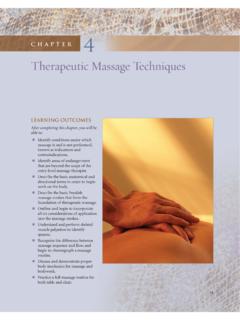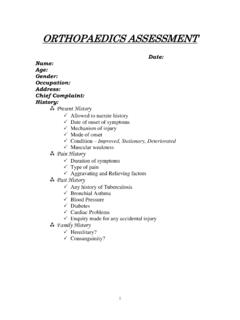Transcription of Physical therapy for Bell's palsy (idiopathic facial ...
1 Physical therapy for bell s palsy ( idiopathic facial paralysis ). (Protocol). Teixeira LJ, Soares BGDO, Vieira VP. This is a reprint of a Cochrane protocol, prepared and maintained by The Cochrane Collaboration and published in The Cochrane Library 2007, Issue 2. Physical therapy for bell s palsy ( idiopathic facial paralysis ) (Protocol) 1. Copyright 2007 The Cochrane Collaboration. Published by John Wiley & Sons, Ltd TABLE OF CONTENTS. ABSTRACT .. 1. BACKGROUND .. 1. OBJECTIVES .. 2. CRITERIA FOR CONSIDERING STUDIES FOR THIS REVIEW .. 2. SEARCH METHODS FOR IDENTIFICATION OF STUDIES.
2 2. METHODS OF THE REVIEW .. 2. POTENTIAL CONFLICT OF INTEREST .. 3. ACKNOWLEDGEMENTS .. 3. SOURCES OF SUPPORT .. 3. REFERENCES .. 3. COVER SHEET .. 4. Physical therapy for bell s palsy ( idiopathic facial paralysis ) (Protocol) i Copyright 2007 The Cochrane Collaboration. Published by John Wiley & Sons, Ltd Physical therapy for bell s palsy ( idiopathic facial paralysis ). (Protocol). Teixeira LJ, Soares BGDO, Vieira VP. This record should be cited as: Teixeira LJ, Soares BGDO, Vieira VP. Physical therapy for bell s palsy ( idiopathic facial paralysis ). (Protocol) Cochrane Database of Systematic Reviews 2006, Issue 4.
3 Art. No.: CD006283. DOI: This version first published online: 18 October 2006 in Issue 4, 2006. Date of most recent substantive amendment: 31 July 2006. ABSTRACT. This is the protocol for a review and there is no abstract. The objectives are as follows: The effectiveness of Physical therapies on the outcome of Bell's palsy ( idiopathic facial palsy ) will be reviewed. BACKGROUND covery a bad prognosis. If recovery begins in one week, 88% obtain full recovery, in one to two weeks 83% and in two to three weeks idiopathic facial palsy , also called Bell's palsy , is an acute disorder 61%.
4 Normal taste, stapedius reflex and tearing give a significantly of the facial nerve, which may begin with symptoms of pain in the better prognosis than if these functions are impaired. Recovery is mastoid region and produce full or partial paralysis of movement less likely to be satisfactory with complete rather than incomplete of one side of the face (Adour 1982; Valen a 2001). Its cause is paralysis , with pain behind the ear and in older people (Danielidis not known (Peitersen 2002). Increasing evidence suggests that the 1999). Other poor prognostic factors include hypertension and main cause of Bell's palsy is reactivation of latent herpes simplex diabetes mellitus (Gilden 2004; Peitersen 2002).
5 Virus type 1 in the cranial nerve ganglia (Diego 1999; Holland 2004; Valen a 2001). How the virus damages the facial nerve is Evaluation of therapy is made difficult because of the high rates of uncertain (Gilden 2004). spontaneous and complete recovery (Peitersen 2002). The princi- ples of treatment in the acute phase have not changed over the past The annual incidence of Bell's palsy varies widely, ranging between 20 years (Adour 1982). They focus on protection of the cornea and cases per 100,000 population (Diego 1999; Peit- from drying and abrasion due to impaired lid closure and tear pro- ersen 2002).
6 There are peaks of incidence in the 30 to 50 year and duction. Lubricating drops are recommended during the day and 60 to 70 year old age groups (Gilden 2004; Gon alvez 1997). a simple eye ointment at night (Holland 2004; Valen a 2001). Bell's palsy has a fair prognosis without treatment (Holland 2004). Cochrane reviews conclude that the available evidence does not According to Peitersen (Peitersen 2002), complete recovery was show significant benefit from aciclovir or similar agents (Allen observed in 71% of all patients. Ninety-four per cent of patients 2005), steroid therapy (Salinas 2005) or acupuncture (He 2005)).
7 With incomplete and 61% with complete paralysis made a com- They recommend large trials with 12 months follow up. Based on plete recovery. The main question is whether results would be bet- a lower standard of evidence, the American Academy of Neurol- ter if some treatment were given. ogy Practice Parameter recommended corticosteroids and antiviral About 23% of people with Bell's palsy are left with either moder- agents in the first week of paralysis (Grogan 2001). The parameter ate to severe symptoms, hemifacial spasm, partial motor recovery, made no recommendation about Physical therapy , although it is crocodile tears, contracture or synkinesis (involuntary twitching of commonly used.)
8 A Cochrane review of exercise for people with the face or blinking). Recurrence occurs in (Valen a 2001). peripheral neuropathy suggested that progressive resisted exercises may improve muscle strength in affected muscles (White 2005). The prognosis depends to a great extent on the time at which re- covery begins. Early recovery gives a good prognosis and late re- Some authors suggest that facial nerve decompression be consid- Physical therapy for bell s palsy ( idiopathic facial paralysis ) (Protocol) 1. Copyright 2007 The Cochrane Collaboration. Published by John Wiley & Sons, Ltd ered, although there are no data from clinical trials to support its another similar facial nerve disability score may be used instead, use (Adour 2002; Gilden 2004; Grogan 2001; Peitersen 2002).
9 Such as that of Van Swearingen (Van Swearingen 1996). Secondary outcome measures will be: Thermal methods, electrotherapy (which uses an electrical current (1) motor synkinesis, crocodile tears or facial spasm six months to cause a single muscle or group of muscles to contract), massage, after onset facial exercises and biofeedback are forms of Physical therapy that (2) incomplete recovery after one year have been used (Mosforth 1958; Peitersen 2002). Exercise therapy (3) adverse effects attributable to the intervention. has been used more than other interventions (Beurskens 2003.)
10 Ross 1991; Segal 1995). There is no known systematic review of these treatments. SEARCH METHODS FOR. IDENTIFICATION OF STUDIES. OBJECTIVES. See: Cochrane Neuromuscular Disease Group methods used in reviews. The effectiveness of Physical therapies on the outcome of Bell's palsy ( idiopathic facial palsy ) will be reviewed. (1) We will search the Cochrane Neuromuscular Disease Group Trials register using the terms ' Bell's palsy ' or ' idiopathic facial paralysis ' or ' facial palsy '. We will also search the Cochrane CRITERIA FOR CONSIDERING Central Register of Controlled Trials (The Cochrane Library, Issue STUDIES FOR THIS REVIEW 3, 2006), MEDLINE (January 1966 to the present), EMBASE.







